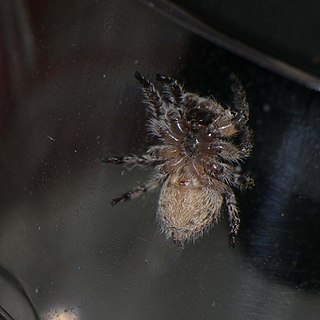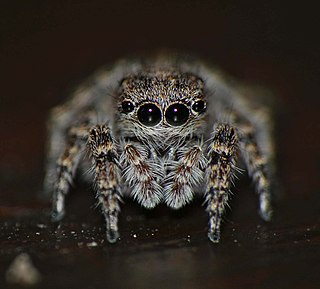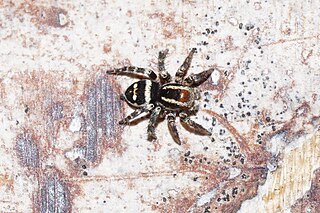
Aelurillus is a genus of spiders in the family Salticidae.

Aelurillus brutus is a species of jumping spider in the genus Aelurillus that lives in Kazakhstan and Turkmenistan. The female was first described by Wanda Wesołowska in 1996 and the male by Galina Azarkina in 2003. The spider is small with a carapace that is between 2.5 and 3.2 mm long and an abdomen between 2.4 and 4.7 mm in length. The female is larger than the male. The spider is generally dark brown and hairy, but the male abdomen has a pattern of grey-yellow wavy lines. The difference between this species and others in the genus are subtle. The females are particularly difficult to distinguish. However, there are three distinctive stripes on the eye field and a pattern on the bottom of the abdomen.

Aelurillus timidulus is a species of jumping spider in the genus Aelurillus that is endemic to Ethiopia. It was first described in 2008 by Wanda Wesołowska and Beata Tomasiewicz. Only the female has been described. It is a small spider with a cephalothorax 2 mm (0.079 in) long and rounded abdomen 2.8 mm (0.11 in) long. The body is black at the front, dark brown at the back of the high pear-shaped carapace and greyish beige across the abdomen. It has a smaller epigyne than others in the genus, but the copulatory organs are otherwise similar to other Aelurillus spiders, having a central pocket and wings alongside the copulatory openings.
Manzuma jocquei is a species of jumping spider in the genus Manzuma that lives in Central African Republic, Ivory Coast and Nigeria. Originally named Aelurillus jocquei, the spider was first described in 2011 by Wesołowska and Antony Russell-Smith. The spider is small, with a carapace between 1.5 and 2.1 mm long and an abdomen between 1.3 and 2.3 mm long. The carapace has a white stripe formed of scales which is more pronounced on the male. The male abdomen also has a stripe, but the female has two lines of white spots. The male has a thin embolus that is hidden by the hairy palpal bulb while the female has complex highly sclerotized copulatory ducts and a large pocket in the epigyne. These distinguish the species from other spiders in the genus, although the females are almost impossible to tell apart from some species like Manzuma lympha and Manzuma nigritibia.

Aelurillus galinae is a species of jumping spider in the genus Aelurillus that is endemic to the United Arab Emirates. It was first described in 2010 by Wanda Wesołowska and Antonius van Harten. The species is small with a cephalothorax that is between 1.5 and 1.8 mm long and an abdomen that is between 1.4 and 2.2 mm long. The female is larger than the male. The female has a spherical abdomen that has a grey and fawn pattern. The male abdomen has a wide brown stripe across the middle and is otherwise yellow. The carapace of both similar. The species is distinguished by the way that the front set of eyes extend beyond the front of the carapace and the way that the appendages on the male palpal bulb have blended.

Langelurillus rufus is a species of jumping spider in the genus Langelurillus that lives in Ethiopia, Kenya and Tanzania. The male was originally described by Roger de Lessert in 1925 and named Langona rufa while male and female samples were named Langelurillus difficilis by Wanda Wesołowska and Anthony Russell-Smith in 2000. The species were combined with the current name in 2012. The spider is small, with a brown carapace that is between 1.9 and 2.0 mm long and an abdomen between 19 and 2.4 mm long. The female can be identified by the orange patches on its carapace. The spider has an abdominal pattern that helps distinguish the species from the related Langelurillus manifestus, which has a brown design on a yellowish abdomen with a brown design while Langelurillus rufus has a yellow design on a brown abdomen.

Langelurillus manifestus is a species of jumping spider in the genus Langelurillus that lives in Tanzania. It was first described in 2000 by Wanda Wesołowska and Anthony Russell-Smith. The spider is small, with a carapace that is between 2.1 and 2.5 mm long and an abdomen between 2.0 and 2.2 mm long. The female carapace is lighter than the male and has a pattern of irregular patches, which may also be found in some examples of the female abdomen. The male abdomen is lighter and has a fawn streak down the middle. The legs are brown, the female having dark rings on its legs. It is similar to other related species, particularly Langelurillus rufus, but can be distinguished by the male's larger size and lighter coloration. The female has an oval epigyne that leads to seminal ducts that are shorter than Langelurillus rufus but longer than Langelurillus squamiger.

Langelurillus horrifer is a species of jumping spider in the genus Langelurillus that lives in Guinea. The female was first described in 2002 by Christine Rollard and Wanda Wesołowska. The male has not been identified. It is a small brown spider with a carapace that measures 2.1 mm (0.083 in) in length and an abdomen that is typically 2.7 mm (0.11 in) long. It is distinguished from similar spiders, like Langelurillus difficilis, by its complicated epigyne with its long spiralling seminal ducts.

Langelurillus sibandai is the largest species of jumping spider in the genus Langelurillus. It lives in Zimbabwe. The female was first described in 2011 by Wanda Wesołowska. The male has not been identified. The spider has a large fawn abdomen that is between 6.9 and 7.1 mm long and a brown cephalothorax between 4.7 and 5.7 mm long. The distinctive bulgy shape of the abdomen helps to distinguish the species, as well as its size. It has short brownish-orange legs and a large triangular epigyne with two small gonopores.

Stenaelurillus fuscatus is a species of jumping spider in the genus Stenaelurillus that lives in Kenya and Tanzania. The species was first identified in 2000 by Wanda Wesołowska & Anthony Russell-Smith, and named for the Latin word for darkish. The spider is medium-sized with a carapace between 2.5 and 3.2 mm long and an abdomen that is between 2.8 and 3.6 in in length. The female carapace is dark brown and has two white stripes and a pattern of a triangle and spots on the abdomen. The colouration is similarly dark but the patterns are less clear. The male abdomen is dominated by a dark scutum. The female is also darker overall, with brown rather than the yellow spinnerets and light brown chelicerae of the male. The male has a hook near the base of the embolus that differentiates it from other species in the genus, while the female's wide insemination ducts sets it apart from the similar Stenaelurillus darwini.

Stenaelurillus kavango is a species of jumping spider in the genus Stenaelurillus that lives in Namibia. It was first described in 2014 by Wanda Wesołowska from a holotype specimen found in the Kavango Region, after which it takes its name. Only the female has been identified. The spider is small, with a brown cephalothorax 2.8 mm (0.11 in) long and an abdomen 3.1 mm (0.12 in) long. The carapace is hairy, dark brown, and has four white streaks, while the abdomen is brown-black with light stripes. It can be distinguished from other members of the genus by the design of the epigyne, which is oval, and its bean-shaped spermathecae.

Stenaelurillus guttiger is a species of jumping spider in the genus Stenaelurillus that is native to southern Africa. It was first described in 1901 by Eugène Simon based on examples found in South Africa, and subsequently also identified in Botswana, Mozambique and Zimbabwe. Initially allocated to the genus Aelurillus, the species was moved to its current genus in 1974. The spider is medium-sized, with a carapace that is between 2.0 and 2.75 mm long and an abdomen that is between 1.8 and 2.9 mm long. It is dark brown or brown, and has a pattern of white hairs on both the abdomen and carapace and a pattern of two stripes on the carapace. The abdomen has a white pattern of straight and V-shaped stripes and spots which varies between specimens. The colouring of the clypeus and legs can also range from yellow to dark brown depending on the particular example. It is distinguished from other species in the genus by the design of its sexual organs. The male has an embolus that is short and crab like. The female has a flat plate epigyne with widely separated copulatory openings and insemination ducts and a deep narrow pocket. Stenaelurillusguttiger feeds on termites, particularly Macrotermes and Odontotermes.

Aelurillus dubatolovi is a species of jumping spider in the genus Aelurillus that lives in Central Asia. First identified in 2003 in Turkmenistan, it has a distribution that extends from Caspian Sea to Lake Balkhash and includes Kazakhstan, Kyrgyzstan, Tajikistan and Uzbekistan. The spider itself is small, the male being smaller than the female, with a carapace measuring between 3.1 and 3.6 mm in length and an abdomen between 2.9 and 4.1 mm long. The carapace is dark brown, with long hairs along the side that distinguish the species from the similar Aelurillus brutus and Aelurillus lutosus. It also has a hairy clypeus and palpal femora, which enables it to be identified as not being the otherwise similar Aelurillus ater. The female has a net-like pattern on the abdomen. This is clearer on examples found towards the northeast of the species distribution. The spiders found towards the northeast are also smaller, lighter and less hairy, but these are insufficient differences to identify them as a different species.

Stenaelurillus albopunctatus is a species of jumping spider in the genus Stenaelurillus that lives in Kenya. It was first described in 1949 by Ludovico di Caporiacco. The spider is medium-sized, with a cephalothorax between 2.24 and 23.55 mm long and abdomen between 2.38 and 3.92 mm long. It has two white stripes on its carapace and white speckles or spots on its abdomen. The female is generally lighter than the male. For example, the female has a brown and yellow carapace, which in the male is brown or black. The female clypeus and legs are yellow, while on the male they are brown. Otherwise, the colouration is similar to many other species in the genus. It is this similarity that led to the species Stenaelurillus guttiger being recognised as a member of the genus. The male has a spatula-like appendage at the front of its yellow pedipalps and a short thick embolus. The female has copulatory openings positioned very closely together and short insemination ducts.

Stenaelurillus bandama is a species of jumping spider in the genus Stenaelurillus that lives in Ivory Coast. Named after the country where it was first found, it was first described in 2018 by Dmitri Logunov and Galina Azarkina. The spider is small, with a carapace between 2.45 and 2.55 mm long and abdomen between 2.4 and 3.1 mm long, although the female is larger than the male. They also differ in colouration. The male carapace is brown and has two white stripes unlike the female's yellow carapace. The male abdomen is dark brown has a pattern of spots and stripes while the female is lighter brown and has a single spot and speckles. The clypeus and legs are also brownish-yellow on the male and yellow on the female. It is similar to Stenaelurillus hirsutus, Stenaelurillus iubatus and Stenaelurillus striolatus but can be distinguished by the lack of hair and presence of a wider vertical stripe on the clypeus, the male's narrow embolus and the female's elongated pocket in the epigyne.

Stenaelurillus senegalensis is a species of jumping spider in the genus Stenaelurillus that lives in Senegal. Named after the country where it was first found, it was first described in 2018 by Dmitri Logunov and Galina Azarkina. The spider is small, with a carapace between 1.7 and 2.5 mm long and abdomen between 1.6 and 3.45 mm long, although the female is larger than the male. The carapace is hairy, brown and has two white stripes. The abdomen differs between the male and female. The male has a pattern of yellow spots and a brown stripe. The female has a cross of yellow stripe and two brown stripes. The male has a bulging palpal bulb while the female has a flat epigyne with widely separated and backward-facing copulatory openings. It is similar to Stenaelurillus nigricaudus, also found in the country, but can be distinguished by the design of its long straight embolus and the lack of pockets in the epigyne.

Stenaelurillus siyamae is a species of jumping spider in the genus Stenaelurillus that lives in Sudan. It was first described in 2018 by Dmitri Logunov and Galina Azarkina from a holotype specimen found by a collector named Siyam in the Dinder National Park. The species takes its name from the collector. Only the female has been identified. The spider is small, with a carapace 2 mm (0.079 in) long and an abdomen 2.3 mm (0.091 in) long. The carapace is hairy, brown and has four white streaks, two made of scales on the body and two made of hairs on the edges, while the abdomen is a mixture of grey, brown and yellow with two large brown stripes flanking a thinner white stripe, all made of hairs. It is similar to Stenaelurillus sudanicus also found in the country but can be distinguished by the design of the epigyne, which is oval, its widely separated facing copulatory openings, and long, S-shaped insemination ducts.

Aelurillus basseleti is a species of jumping spider in the genus Aelurillus that has been found in Algeria, Morocco and Tunisia. Originally named Salticus basseleti, the spider was first identified in 1846 by Hippolyte Lucas, but the original male holotype has been lost. The female was first described in 2006. The spider is small and hard to distinguish from the related species Aelurillus luctuosus and Aelurillus monardi. The dark brown carapace is typically between 2.8 and 3.4 mm long and the grey-yellow abdomen is between 2.3 and 4 mm long, the female being larger than the male. The carapace has a single stripe down the middle. While the female is hard to distinguish compared to others in the genus, the male spider has distinctive white or tawny bands on the clypeus. The male has a curved embolus that is sufficiently varied between individual spiders that it is not sufficiently specific to identify the species.

Aelurillus hirtipes, synonym Aelurillus sinaicus, is a species of jumping spider in the genus Aelurillus that lives in North Africa. First identified by Jacques Denis in Chad in 1960 as part of the Missions Berliet-Ténéré, it has also been found in Algeria, Egypt and Morocco. The spider is small, with a brown carapace that is between 3.5 and 3.6 mm long and a yellow abdomen that measures between 3 and 4 mm in length. The male has a small hooked embolus protruding from its palpal bulb and the female has S-shaped flaps on the epigyne and short copulatory ducts. The spider has a covering of light hairs, whiter on the female and more yellow on the male. These hairs help distinguish it from the related Aelurillus v-insignitus and Aelurillus plumipes

Stenaelurillus nigricaudus, synonyms Aelurillus sahariensis and Stenaelurillus nigritarsis, is the type species of the genus Stenaelurillus. It is a jumping spider that lives in Algeria, Burkina Faso, Gambia, Mali, Niger and Senegal. The male was first described by Eugène Simon in 1886 and the female initially in 1936 by Ludovico di Caporiacco and more thoroughly by Nikolaj Scharff and Tamás Szűts in 2005. It is a medium-sized spider with a cephalothorax between 2.4 and 2.7 mm and an abdomen that is between 2 and 3.7 in long. The carapace is reddish-brown and has two white or yellow stripes. The female abdomen has a pattern of stripes and spots, with some examples having brown spots inside yellow spots. The male abdomen has either a single dark stripe or two white and one brown stripes. While the female pedipalps are yellow, the male has either dark or brown pedipalps. The female has distinctive flanges at its copulatory openings. The male is distinguished by the shape of its palpal bulb and, particularly, of its hook-shaped embolus.












